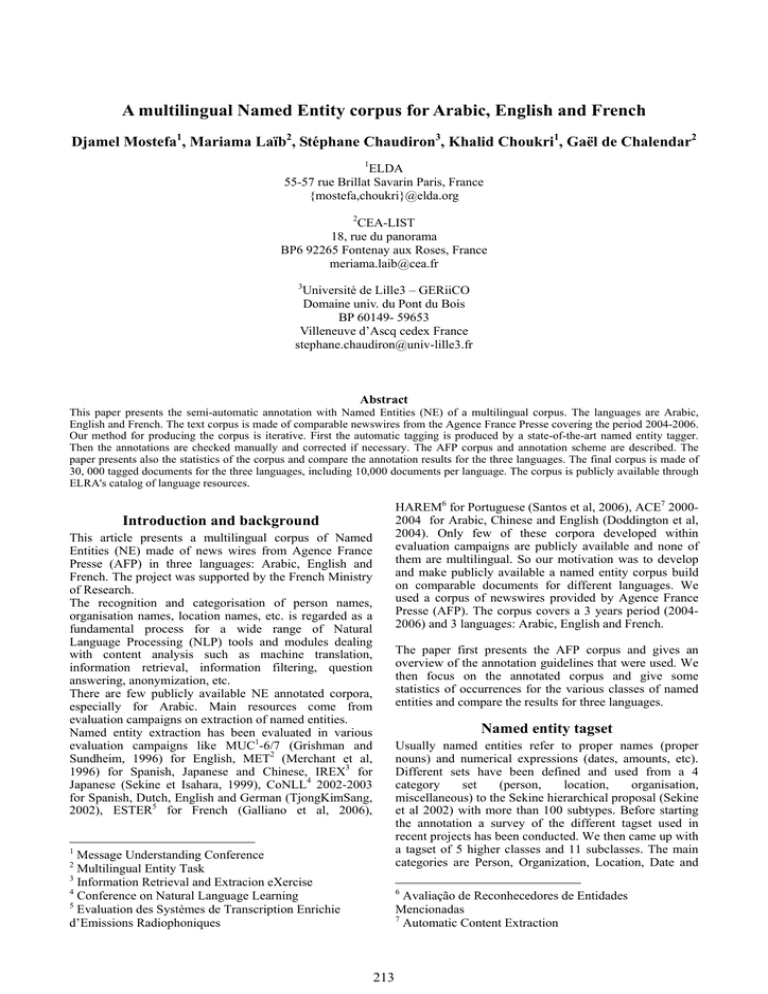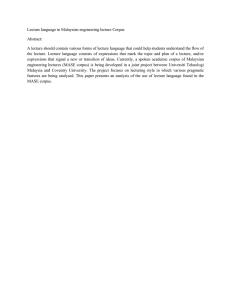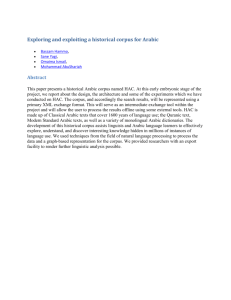A multilingual Named Entity corpus for Arabic, English and French
advertisement

A multilingual Named Entity corpus for Arabic, English and French
Djamel Mostefa1, Mariama Laïb2, Stéphane Chaudiron3, Khalid Choukri1, Gaël de Chalendar2
1
ELDA
55-57 rue Brillat Savarin Paris, France
{mostefa,choukri}@elda.org
2
CEA-LIST
18, rue du panorama
BP6 92265 Fontenay aux Roses, France
meriama.laib@cea.fr
3
Université de Lille3 – GERiiCO
Domaine univ. du Pont du Bois
BP 60149- 59653
Villeneuve d’Ascq cedex France
stephane.chaudiron@univ-lille3.fr
Abstract
This paper presents the semi-automatic annotation with Named Entities (NE) of a multilingual corpus. The languages are Arabic,
English and French. The text corpus is made of comparable newswires from the Agence France Presse covering the period 2004-2006.
Our method for producing the corpus is iterative. First the automatic tagging is produced by a state-of-the-art named entity tagger.
Then the annotations are checked manually and corrected if necessary. The AFP corpus and annotation scheme are described. The
paper presents also the statistics of the corpus and compare the annotation results for the three languages. The final corpus is made of
30, 000 tagged documents for the three languages, including 10,000 documents per language. The corpus is publicly available through
ELRA's catalog of language resources.
HAREM6 for Portuguese (Santos et al, 2006), ACE7 20002004 for Arabic, Chinese and English (Doddington et al,
2004). Only few of these corpora developed within
evaluation campaigns are publicly available and none of
them are multilingual. So our motivation was to develop
and make publicly available a named entity corpus build
on comparable documents for different languages. We
used a corpus of newswires provided by Agence France
Presse (AFP). The corpus covers a 3 years period (20042006) and 3 languages: Arabic, English and French.
Introduction and background
This article presents a multilingual corpus of Named
Entities (NE) made of news wires from Agence France
Presse (AFP) in three languages: Arabic, English and
French. The project was supported by the French Ministry
of Research.
The recognition and categorisation of person names,
organisation names, location names, etc. is regarded as a
fundamental process for a wide range of Natural
Language Processing (NLP) tools and modules dealing
with content analysis such as machine translation,
information retrieval, information filtering, question
answering, anonymization, etc.
There are few publicly available NE annotated corpora,
especially for Arabic. Main resources come from
evaluation campaigns on extraction of named entities.
Named entity extraction has been evaluated in various
evaluation campaigns like MUC1-6/7 (Grishman and
Sundheim, 1996) for English, MET2 (Merchant et al,
1996) for Spanish, Japanese and Chinese, IREX3 for
Japanese (Sekine et Isahara, 1999), CoNLL4 2002-2003
for Spanish, Dutch, English and German (TjongKimSang,
2002), ESTER5 for French (Galliano et al, 2006),
The paper first presents the AFP corpus and gives an
overview of the annotation guidelines that were used. We
then focus on the annotated corpus and give some
statistics of occurrences for the various classes of named
entities and compare the results for three languages.
Named entity tagset
Usually named entities refer to proper names (proper
nouns) and numerical expressions (dates, amounts, etc).
Different sets have been defined and used from a 4
category
set
(person,
location,
organisation,
miscellaneous) to the Sekine hierarchical proposal (Sekine
et al 2002) with more than 100 subtypes. Before starting
the annotation a survey of the different tagset used in
recent projects has been conducted. We then came up with
a tagset of 5 higher classes and 11 subclasses. The main
categories are Person, Organization, Location, Date and
1
Message Understanding Conference
Multilingual Entity Task
3
Information Retrieval and Extracion eXercise
4
Conference on Natural Language Learning
5
Evaluation des Systèmes de Transcription Enrichie
d’Emissions Radiophoniques
2
6
Avaliação de Reconhecedores de Entidades
Mencionadas
7
Automatic Content Extraction
213
Numex. Organization and Date are divided into 2
subcategories while Location is divided into 5 categories.
standard designed to provide a media-independent,
multilingual structural framework for multimedia news.
Person names
Statistics of the whole corpus are depicted in Table 1.
Are annotated as Person entities, word or groups of words
referring to real persons, fictional characters or religious
deities. We also annotate as Person: nicknames, alias,
titles and roles when they refer to persons and are not
ambiguous.
Wire
# documents
# words
Arabic
254 847
56 M
French
448 660
123 M
English
758 578
245 M
Total
1 462 085
424 M
Organization names
Are tagged as Organization entities, words referring to
organizational structures in different domains such as
sport teams, political parties, enterprises, etc. According
to different contexts where the entity appears, and in order
to resolve ambiguities, this class is divided into two
subclasses: Organization.Org and Organization.GPE (Geo
Political Entity). The first one annotates organization
names used as such and the second one annotates location
names when refer to organisations such as “France had
decided not to go ahead with the flight after Britain”.
Table 1 Statistics of the AFP corpus
Location names
In term of words, the Arabic corpus contains 56 millions
of running words. The English corpus is made of 245
millions of words. The French corpus contains 123
million of words.
This class annotates all locations and is divided into seven
subclasses:
• Location.Geo: geographical location such as
lakes, seas, mountains, etc.
• Location.Fac: buldings and facilities,
• Location.Line: roads and motorways,
• Location.Post.Addr: street addresses
• Location.Url.Addr: emails and web addresses,
• Location.Tel.Addr: phone numbers and faxes,
• Location.GPE: this subclass annotates location
names when the context is referring to
organizations.
Annotation procedure
The documents are annotated in two steps. First, the
named entities are recognized automatically in the
documents using LIMA (LIC2M Multilingual Analyzer),
a linguistic analyzer developed by the CEA LIST
(Besançon et al., 2003). The named entities recognizer is a
module of this analyzer which uses a set of rules and a list
of special triggers (e.g., Miss, Mr Mme, President, lake,
corporation, etc.) to identify named entities8 and their
types. These rules were adapted in order to consider the
tagset of the categories in this project. Rules are activated
when a trigger is found in the text. Then, the recognizer
verifies right and left contexts in order to identify named
entities when they exist. For example, in the sentence
“”أآﺪت وزارة اﻟﺪاﺧﻠﻴﺔ اﻟﻌﺮاﻗﻴﺔ, the word “ ”وزارةis considered
as a trigger. In this case, the rule that allows the
recognizer to identify “ ”وزارة اﻟﺪاﺧﻠﻴﺔ اﻟﻌﺮاﻗﻴﺔas an
Organization name stipulates that: if this trigger is
preceded directly by a verb and followed by one or two
specific adjectives, then the sequence of these two or tree
words is tagged as an Organization entity. According to
the right context, this sequence of words can be tagged as
a Location entity if the first word is preceded by
prepositions as “ ” ﻓِﻲor “ ” ِإﻟَﻰand nouns as “ ”ﻣﻮﻗﻊor
“”ﺑﻨﺎء. Before this named entities recognition process,
words are analyzed and tagged with their grammatical
categories.
Then the annotations are checked and corrected manually.
We recruited six annotators (two per language) for the
manual correction. The annotators worked 4 hours per day
since the task needs a high level of concentration. At the
DateTime tags
This class annotates expressions of time. This class is
divided into two subclasses:
• dateTime.Time: hours, minutes, periodes, etc.
• dateTime.date: relative or absolute dates.
Numex tags
This class is used for numerical entities such as: distance,
speed, weight, age, etc.
This tagset is compatible with the information containing
in this kind of corpora and can be interesting to use in
technology watch applications.
The AFP corpus
The corpus is provided by the Agence France Presse
(AFP).
We selected 3 languages (Arabic, English and French) and
a 3 years period (2004-2006) which represents a
collection of about one and half millions newswires for
around 10 GB and 424 millions words, from which 10,000
documents of each language have been selected to be used
for the annotation with named entities. News articles are
encoded in XML format and follow the News Markup
Language (NewsML) specifications. NewsML is an XML
8
Originally, our system is able to recognize five types of
named entities: Person, Organization, Location, Numex and Timex.
214
end of the project, the annotators could validate 50
documents per half-day which means that the ratio is
around 12 documents per working hour.
The 24 722 remaining documents are automatically
annotated but couldn't be corrected manually.
Annotation tool
The annotation tool Annoqt has been developed by the
CEA. It is a generic annotation tool and is very easy to
use. It has been developed using the Qt library. As such, it
is lightweight and multiplatform. It has been used under
Windows and Linux platforms but it should be usable on
any platform supported by Qt, like MacOS or mobile
devices.
Thanks to the Qt library, Annoqt is natively multilingual.
It particularly handles gracefully right-to-left languages
and non-latin scripts. Thus, it is able to deal with the three
languages of the corpus.
Using Annoqt, the user annotates segments of text with
colors by selecting them with the mouse and then clicking
on the desired color. Each color is associated to a Named
Entity type (Person, Numex, Organization...) using a
XML configuration file. A graphical configuration editor
is offered in order to simplify the setup of the
configuration.
Figure 2 shows an Arabic text being annotated. One can
see on the left side the list of colored named entities types
and the main annotation window on the right side. If the
user clicks on an existing annotation, it selects it and he or
she can then remove the annotation using the scissors tool
or change its type by choosing a new one in the left panel
list. You can see that Annoqt also supports overlapping
entities (or even entities completely embedded inside
other entities). This is shown by text segments decorated
with colors gradients using the colors of all the entities
types involved. When the user clicks with the left mouse
button on such a segment, a contextual menu is displayed
allowing him or her to select one of the entities.
Annoqt offers a few other features, like reusing the last
used entity type on a new text segment or repeating the
same annotation on all same strings of the text.
This is the first version of Annoqt. Future versions will be
made easier to use in other projects by making pluggable
the annotation format that is currently fixed. We also hope
to be able to quickly release it under a Free Software
license.
Table 2 shows some statistics on the automatically
annotated corpus and the manual one.
Ara
Automatic annotation
#doc
#word #NE
10k
2.4 M 190k
Manual annotation
#doc #word
#NE
2,316 538k
106k
Eng
10k
3.4 M
261k
1,177
393k
43k
Fre
10k
2.9 M
228k
1,785
517k
78k
Table 2 Statistics on the automatic annotated corpus and
the manual annotated corpus
We present here some statistics on the manually annotated
part of the corpus.
We can see that the corpus is very rich in named entities.
The English part contains 43,124 occurrences of named
entities from 5,667 different entities. For French there are
78,442 occurrences from 10,377 named entities. For
Arabic 106,434 occurrences of named entities were
annotated. So the average number of named entities per
document is 36 for English, 44 for French and 46 for
Arabic.
For the three languages, the classification between
categories is identical. The most frequent category is
Location, then Organization, Person, Date and Numex.
Figure 1 gives an overview of the classification for the
Arabic corpus. The repartition is not very surprising since
the AFP corpus deals with news in general and therefore
Geo Political Entities (GPE) are very present and are
annotated either as Location.GPE or Ogranization.GPE.
NUM
12%
LOC
30%
Corpus statistics
DA TE
16%
We selected the most recent 10,000 news wires per
language from the whole AFP corpus for the annotation.
More precisely the English corpus is made of news from
November 15 to November 29, 2006 while the French
corpus contains news from October 22 to November 30,
2006 and the Arabic one range from October 1 to
November 28, 2006.
PERS
16%
ORG
26%
At the beginning of the project, we planned to manually
annotate the whole corpus composed of 30 000
documents. But the effort was much more important than
expected and therefore we couldn't annotate the whole
corpus within the project. In total, 5 278 documents were
manually annotated, 1 177 for English, 1 785 for French
and 2 316 for Arabic.
Figure 1 Named entities repartition for the Arabic news
wires
215
Conclusion
Conference on Language Resources and Evaluation
(LREC 2004), Lisboa, Portugal.
Galliano S., Geoffrois E., Gravier G., Bonastre J.F.,
Mostefa D. and Choukri K. (2006). Corpus description
of the ESTER Evaluation Campaign for the Rich
Transcription of French Broadcast News. In
Proceedings of the 5th International Conference on
Language Resources and Evaluation, LREC 2006,
Genoa, Italy.
Grishman, R and Sundheim, B, (1996). Message
Understanding Conference-6: a brief history. In
Proceedings of the 16th Conference on Computational
linguistics. Morristown, NJ, USA.
Merchant, R., Okurowski, M. and Chinchor, N. (1996).
The multilingual entity task (MET) overview. In
Proceedings of a workshop on held at Vienna, Virginia,
pages 445–447, Morristown, NJ, USA. Association for
Computational Linguistics.
Santos D., Seco,N., Cardoso N. and Vilela, R. (2006).
HAREM : An Advanced NER Evaluation Contest for
Portuguese. In Proceedings of the 5th International
Conference on Language Resources and Evaluation,
LREC 2006, Genoa, Italy.
Sekine S. and Isahara H. (1999). IREX project overview.
In Proceedings of the Information Retrieval and
Extraction Exercise, Japan.
Sekine, S. Sudo, K. and Nobata, C. (2002) Extended
Named Entity Hierarchy. In Proceedings of 3rd
International Conference on Language Resources and
Evaluation. Las Palmas, Spain.
TjongKimSang E. (2002). Introduction to the CoNLL2002 shared task: language-independent named entity
recognition. In Proceedings of the 6th conference on
Natural language learning, Morristown, NJ, USA.
In this paper we presented the corpus of named entities
build on the AFP corpus. The database is made of 30 000
news wires in Arabic, English and French. The corpus
was annotated semi automatically with the help of a stateof-the-art NE tagger. We provided detailed information on
the annotation scheme, the content of the corpus and
statistics of occurrences of NE tags.
In order to minimize the cost of the manual validation, we
have to adapt the rules used in our system so that the
quality of the automatic recognition is improved. This is
what we plan to do in the next step of the project using the
corpus already tagged and checked. We plan to tag 30 000
documents in each language.
The corpus is publicly available through ELRA’s catalog
of language resources (http://catalog.elra.info) for
research or commercial use.
Acknowledgements
The project is funded by the French Ministry of Research.
Bibliographical References
Besançon R., de Chalendar G., Ferret O., Fluhr C.,
Mesnard O., and Naets H. (2003) The LIC2M’s CLEF
2003 system. In Working Notes for the CLEF 2003
Workshop, August 2003.
Doddington G., Mitchell A., Przybocki M., Ramshaw L.,
Strassel S. and Weischedel R. (2004). The Automatic
Content Extraction (ACE) program tasks, data, and
evaluation. In Proceedings of the 4th international
Figure 2 Screenshot of the annotation tool Annoqt
216


